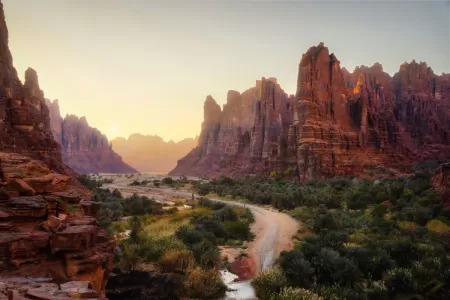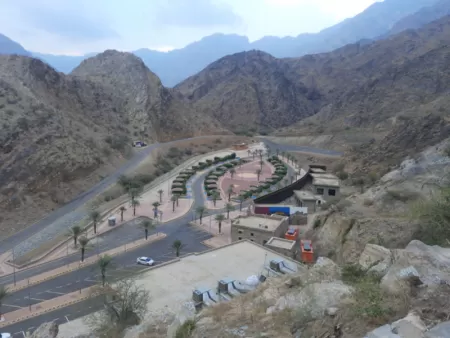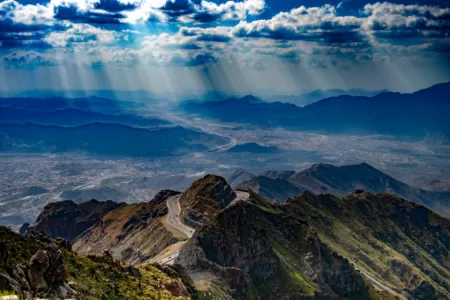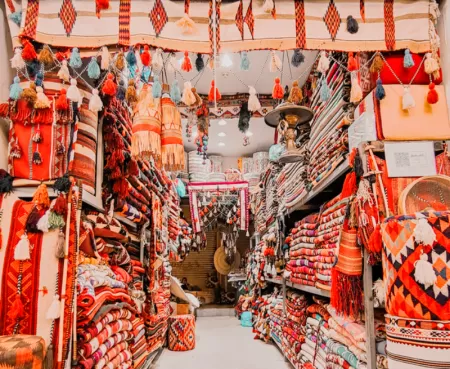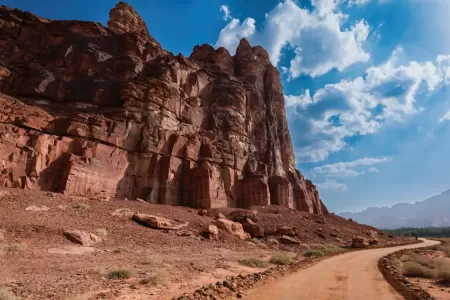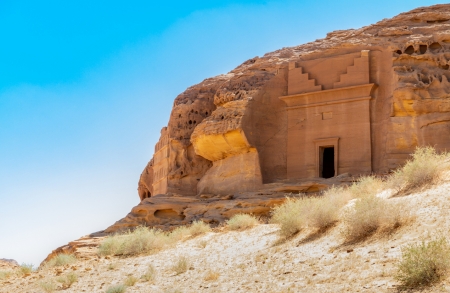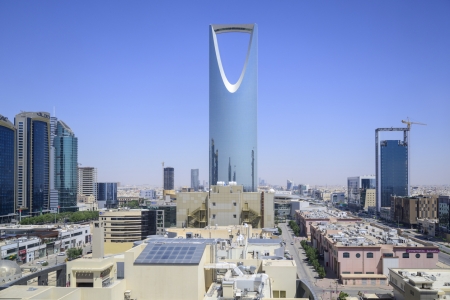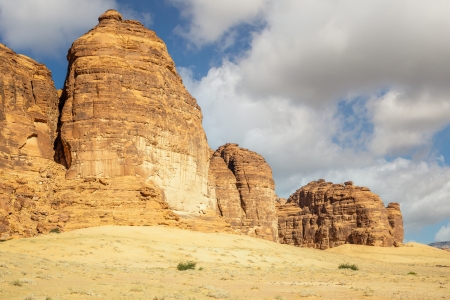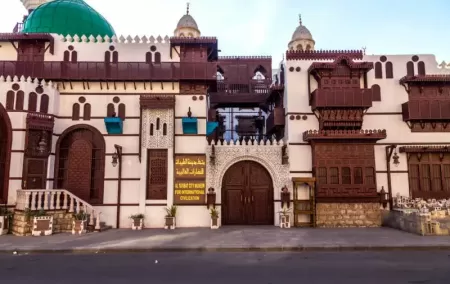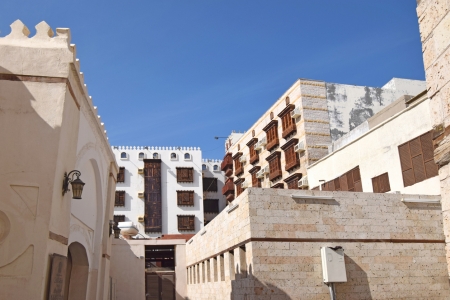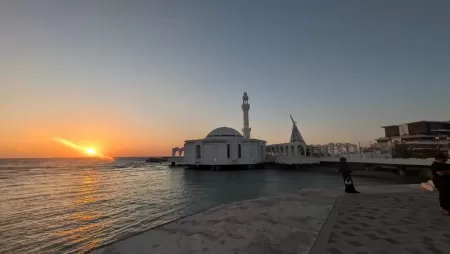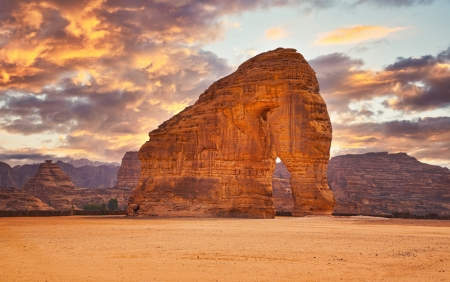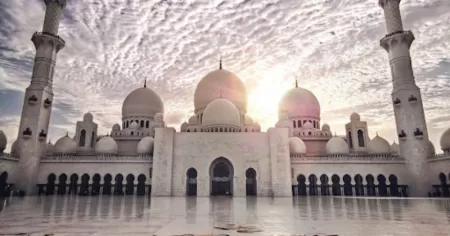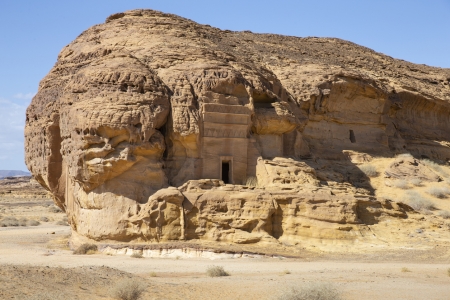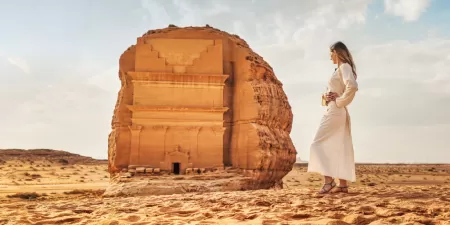Elephant Rock Saudi Arabia
Elephant Rock, also known as Jabal AlFil, is one of AlUla’s most iconic natural landmarks. Towering over the golden desert, this massive sandstone formation resembles an elephant with its trunk touching the ground. Surrounded by scenic views and peaceful desert landscapes, Elephant Rock offers a perfect setting for sunset photography, stargazing, or simply enjoying the serene beauty of Saudi Arabia’s natural wonders. Easily accessible and often paired with nearby heritage sites, it's a must-visit highlight on any AlUla or Saudi Arabia tour.

Jabal AlFil, commonly known as Elephant Rock, soars a staggering 52 meters above the desert landscape, representing one of nature's most exquisite geological masterpieces. This colossal sandstone behemoth has been meticulously sculpted over millions of years through persistent natural forces—wind currents, rainfall patterns, and relentless sand erosion—resulting in a formation that bears a remarkable likeness to an elephant with its trunk gently touching the ground.
The magnificent monolith stands proudly in Al-Ula's historic territory, Northwestern Saudi Arabia, captivating the imagination of global travelers who journey to witness its grandeur. Visitors discover ancient petroglyphs and inscriptions etched into the surrounding rocks, silent narrators of civilizations that flourished centuries ago. The golden hour just before sunset bathes the formation in amber light, creating unparalleled photographic moments that capture the rock's majestic presence. Nightfall brings another dimension to the experience—strategically placed illumination transforms the ancient structure into a luminous wonder against the desert night, revealing contours and features invisible during daylight hours.
The Story Behind Saudi Arabia's Elephant Rock
Jabal AlFil, the Arabic name bestowed upon this monumental formation, translates directly to "Mountain of the Elephant". This geological masterpiece rises majestically from AlUla's sweeping desert panorama, embodying both scientific importance and a cultural legacy that stretches back through numerous centuries.
Ancient legends of Jabal AlFil:
Across the annals of time, this imposing rock structure has transcended its role as mere geological curiosity to become a pivotal landmark and cultural touchstone for generations of inhabitants throughout the region. AlUla itself stands as a historical nexus where multiple civilizations converged, weaving a rich tapestry of myths and narratives tied to this singular formation.
Sharp-eyed visitors often detect faded inscriptions and ancient markings across the rock's weathered surface, subtle clues pointing to the area's profound historical significance. These mysterious elements add compelling dimensions to an already captivating natural monument. Reaching skyward 52 meters against the vast Arabian horizon, Elephant Rock has stood as silent witness to countless human journeys through this historically crucial passageway.
Regional storytelling traditions link the formation to elaborate tales of bygone societies and mythical beings that supposedly roamed these lands in distant eras. While these narratives differ in their specific details, they universally underscore the rock's central importance within Saudi Arabian cultural heritage. The steadfast presence of this formation amid the desert landscape has established it as a natural focal point around which human stories have naturally coalesced across generations.
How the formation got its name
The remarkable elephant-like silhouette of Jabal AlFil strikes observers immediately upon viewing. When gazed upon from a distance, the rock portrays an unmistakable pachyderm with its trunk extended to touch the earth—a likeness so precise that its naming seemed predestined.
Unlike Hegra's elaborately hand-carved Nabataean tomb facades nearby, this enormous stone sculpture emerged exclusively through Earth's natural processes. The passage of millions of years allowed wind currents, water flows, and sand erosion to function as patient sculptors, gradually shaping the ruddy sandstone into its current elephant form. Geologists note the formation's specific northwest-to-southeast orientation, which provides the perfect alignment to create this uncanny resemblance.
Scientific analysis suggests the rock structure may date back approximately 200 million years, standing as extraordinary testimony to nature's artistic prowess. Approaching this geological phenomenon allows appreciation for the extraordinary detail with which natural elements have carved what appears to be the distinct body, head, and trunk of a colossal elephant.
The name Jabal AlFil perfectly encapsulates the formation's essence—a visual accuracy so compelling that no alternative title would suffice. Though modern tourists may discover Elephant Rock as newcomers, its distinctive outline has likely evoked similar impressions from wanderers and residents throughout countless centuries past.
Experiencing the Wonder of Elephant Rock
Jabal AlFil delivers a sensory journey that morphs dramatically between daylight hours and nightfall. Visitors seeking this extraordinary experience may venture to the site daily between 4:00 PM and 11:40 PM, with Thursdays and Fridays offering extended exploration until 12:40 AM.
First impressions upon arrival:
Most travelers experience an immediate sense of wonder upon first glimpsing this natural monument. The massive formation reaches skyward 52 meters at its zenith, its warm red sandstone hues contrasting magnificently against the surrounding desert palette. Remarkably, access to this geological masterpiece comes without the burden of entrance fees—a rarity among comparable global attractions.
The formation commands attention across the landscape, its distinctive silhouette creating the perfect illusion of an elephant drinking from an imagined water source. Observant visitors will note fellow travelers strategically positioning themselves around the formation, each seeking that perfect photographic angle to capture the rock's remarkable elephant-like contours.
Walking around the formation:
Circumnavigating the base reveals extraordinary details of nature's patient artistry—evidence of wind and water forces that shaped this sandstone giant across geological epochs. Travelers should note that October through April provides optimal visiting conditions, with winter months particularly pleasant as temperatures hover between 15°C and 25°C (59°F to 77°F).
The site features thoughtfully appointed visitor amenities, including plush circular seating arrangements, strategically placed coffee tables, and immaculate restroom facilities. Culinary options abound near the formation, with establishments like Burger Chefs, Alfa's Retreat, and Heritage Garden offering delectable local fare.
Evening light shows and illumination:
Dusk heralds a complete transformation of the rock experience. Strategic lighting bathes the formation in radiance while subtle musical notes drift through the desert air. The atmospheric setting beckons visitors to claim space beside crackling firepits, perfect vantage points from which to witness the formation's changing appearance as daylight surrenders to evening.
Natural lunar illumination works in concert with the vast starscape overhead, creating ideal conditions for celestial observation. Astronomy enthusiasts frequently arrive equipped with telescopic equipment, taking advantage of the area's remarkable darkness, far removed from urban light pollution. These evening hours provide a tranquil setting in which to contemplate the ancient presence that has stood sentinel over this landscape for millennia.
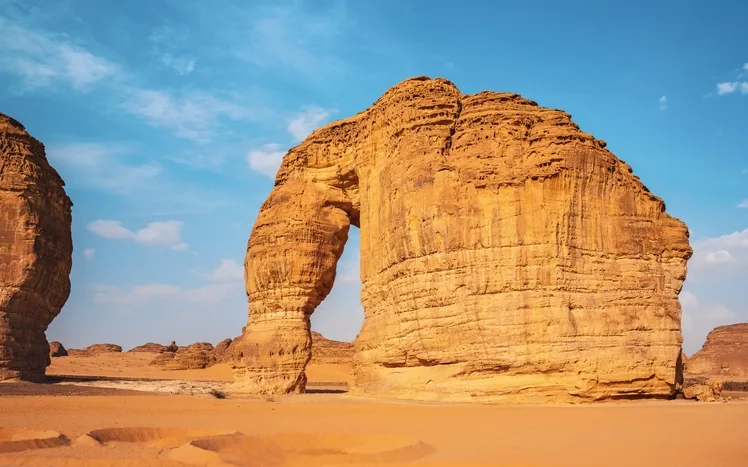
Beyond the Rock: AlUla's Natural Treasures:
AlUla unfolds beyond Elephant Rock as a vast panorama of natural and cultural marvels awaiting discovery during Saudi Arabian journeys. This ancient oasis cradles extraordinary attractions that illuminate the region's storied heritage and showcase its breathtaking geological features.
Hegra UNESCO World Heritage Site:
Hegra stands proudly as Saudi Arabia's inaugural UNESCO World Heritage Site and the crowning achievement among AlUla's historical treasures. This Nabataean settlement showcases 111 remarkably preserved monumental tombs sculpted directly into sandstone outcrops. Visitors marvel at 94 of these structures adorned with elaborate decorative elements that demonstrate cultural interchanges between numerous ancient civilizations.
The city reached its zenith between 50 BCE and 106 CE, functioning as the southern capital of the Nabataean kingdom and securing a crucial position along the prosperous Incense Road. Archaeological exploration reveals sophisticated ancient engineering accomplishments including intricate well systems, carefully constructed stone-lined water channels, and defensive fortifications exhibiting distinct Roman architectural influence. Visitors access this archaeological wonder exclusively through organized tours, conducted via either vintage Land Rovers or comfortable coaches, with entry beginning at SAR 95.
Maraya Concert Hall:
Maraya—Arabic for "mirror"—commands attention as an architectural triumph officially recognized by Guinness World Records as the planet's largest mirrored structure. The building's exterior features 9,740 precisely arranged reflective panels that capture and project the surrounding desert vistas, generating a mesmerizing optical phenomenon wherein the building seemingly dissolves into the landscape before reappearing against towering sandstone escarpments.
Within this remarkable structure resides a sophisticated 500-seat performance space that has welcomed global musical luminaries including Andrea Bocelli, Alicia Keys, and John Legend. Architectural ingenuity manifests in the 26-meter floor-to-ceiling facade designed to retract completely, revealing sweeping panoramas across Ashar Valley. Crowning this extraordinary venue, Maraya Social presents fine dining under the direction of celebrated British chef Jason Atherton, offering culinary journeys through Mediterranean, British, and Middle Eastern gastronomic traditions.
Desert landscapes and stargazing opportunities:
AlUla's natural wonders extend well beyond architectural achievements, particularly within the boundaries of Sharaan Nature Reserve. Adventurous spirits explore Madakhel Canyon's winding sandstone corridors through expertly guided excursions provided by Husaak Adventures. Celestial enthusiasts celebrate the region's designation as Saudi Arabia's first Dark Sky Park, creating ideal conditions for astronomical observation.
Winter months—particularly December through February—provide ideal conditions for exploring AlUla's natural splendors, with pleasant temperatures fluctuating between 59°F and 77°F. This favorable climate coincides fortuitously with AlUla's dynamic festival calendar, presenting visitors with exceptional cultural engagement opportunities.
Saudi Arabia Trips: Incorporating Elephant Rock:
Crafting a journey to witness Elephant Rock demands thoughtful itinerary development. The geological wonder serves as a cornerstone experience whether visitors pursue brief encounters or extensive explorations across Saudi Arabia's diverse landscapes.
Sample itineraries for AlUla exploration:
AlUla reveals its treasures most effectively through strategically planned itineraries centered around Jabal AlFil:
One-Day AlUla Highlights:
Morning: Wander through AlUla's Old Town and vibrant local marketplaces
Afternoon: Delve into the ancient wonders of Hegra UNESCO site
Evening: Position yourself at Elephant Rock for sunset spectacles (prime photographic moments)
Night: Bask in the illuminated formation's glow while gathered around crackling firepits
Most visitors find 1-2 hours sufficient for experiencing Elephant Rock , allowing seamless integration into broader regional exploration. Photography devotees might consider extended time allocations, particularly during the golden hour when sunlight transforms the sandstone hues dramatically . Following your exploration, culinary refreshment awaits at nearby food establishments or the distinctive SALT restaurant .
Combining with other Saudi destinations:
Jabal AlFil functions superbly as a central element within expanded Saudi Arabian discovery. Seasoned travelers frequently pair their AlUla sojourn with:
AlUla-Focused Extended Stay: Dedicate 2-3 days to uncover AlUla's diverse attractions including Harrat Viewpoint (widely acclaimed as "the best viewpoint" among visitors) and Jabal Ikmah with its fascinating ancient inscriptions .
- Multi-Region Journey: Extend your northern Saudi experience by connecting AlUla with exploration of Tabuk or Khaybar regions.
Regardless of selected travel patterns, Elephant Rock offers straightforward accessibility via Highway 70, complemented by complimentary parking facilities at the site .
Guided vs. self-guided tours to Saudi Arabia:
The decision between guided expertise and independent discovery hinges upon several key considerations:
Self-Guided Benefits:
Admission to Elephant Rock itself requires no entry fee
Complete autonomy to explore according to personal rhythm and interests
Self-driving option available directly via Highway 70
Guided Tour Advantages:
Illuminating commentary providing historical context and cultural significance
Logistical convenience through arranged transportation (hotel collection services widely available)
Fluid progression between multiple regional attractions
First-time Saudi Arabia visitors often benefit from guided experiences beginning at $68 , providing essential contextual understanding. These curated excursions typically encompass visits to Old Town, Ashar Valley, and the Maraya structure alongside Elephant Rock .
Alternatively, independent spirits may prefer the flexibility of "Build Your Own Itinerary" options , allowing personalized approaches throughout Saudi explorations.

FAQs:
1. When is the ideal time to visit Elephant Rock in Saudi Arabia?
The best time to visit Elephant Rock is during the winter months from December to February when temperatures are comfortable, ranging from 15°C to 25°C (59°F to 77°F). This period also coincides with AlUla's festival season, offering additional cultural experiences.
2. How tall is Elephant Rock and what makes it unique?
Elephant Rock stands an impressive 52 meters (171 feet) tall. What makes it unique is its uncanny resemblance to an elephant with its trunk touching the ground, formed entirely by natural erosion over millions of years.
3. Are there any fees to visit Elephant Rock?
There is no entrance fee to visit Elephant Rock. It's freely accessible to all visitors during its operational hours, which are typically from 4:00 PM to 11:40 PM daily, with extended hours on Thursdays and Fridays.
4. What activities can visitors enjoy at Elephant Rock?
Visitors can walk around the formation, enjoy the evening light shows and illumination, relax near firepits, stargaze, and take stunning photographs, especially during sunset. There are also nearby dining options and comfortable seating areas to enhance the experience.
5. How can Elephant Rock be incorporated into a broader Saudi Arabia trip?
Elephant Rock can be easily combined with other attractions in AlUla,
such as the Hegra UNESCO World Heritage Site and Maraya Concert Hall. It's also possible to include it in multi-region journeys, connecting with destinations like Tabuk or Khaybar for a comprehensive northern Saudi experience.
Don’t miss this wonder on your Saudi Arabia Tours - Book your Journey Now!
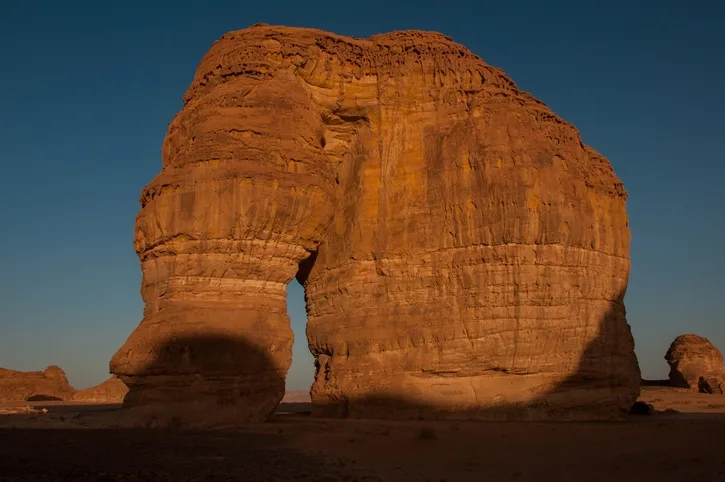
Customize Your Dream Vacation!
Get in touch with our local experts for an unforgettable journey.
Plan Your Trip





